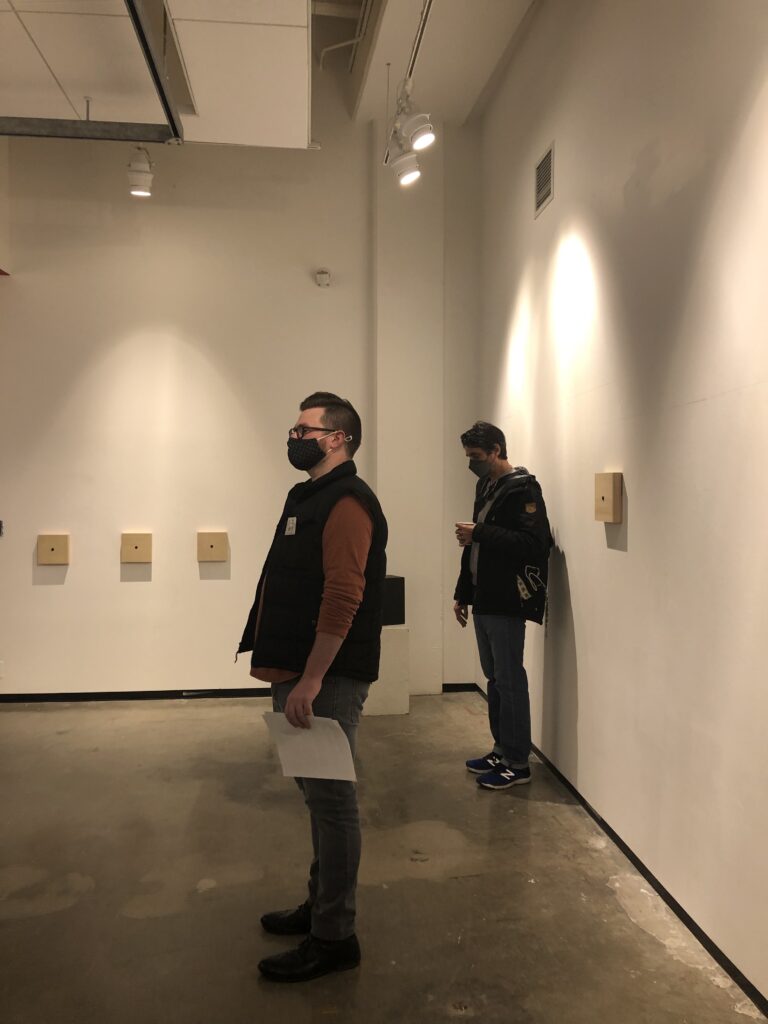Sound and Space | Interactive Sound Installation
Sound and Space is an interactive electroacoustic environment in which visitors to the space shape the ambient sound, consciously and unconsciously. Ultrasonic rangefinders are mounted throughout the space and wirelessly transmit proximity data to software that synthesizes, transforms, and disperses the sound in space. Sonically, the installation is characterized by subtle, continuous sounds that are shaped and projected using site-specific loudspeaker arrays (up to 16 channels) and acoustic treatments.
The recording below is taken from the first production of the installation at Rice University on April 19-21, 2012, supported by a grant from the Sviatoslav Richter Outreach Fund from the Shepherd School of Music. Visual and architectural elements were designed and executed by Liang Wang. In addition, during the run solo musicians periodically improvised with the ambient sound. In this recording, percussionist Andy Keller is improvising with the installation.
Visitors enter the space without an explanation of the nature of the interaction. The priorities in defining a paradigm for interaction are (1) to allow anyone entering the space to immediately begin interacting with the installation through their movement and (2) to create a system that is sufficiently complex so as to reward visitors who choose to spend more time exploring the installation, so that they may intentionally "perform" a more sophisticated interaction.
The following video is taken from a 2013 production of Sound and Space at Brooklyn Launchpad, featuring Ronen Shai improvising with the installation.
Depending on the space of the installation, various interactive paradigms have been implemented. For example, the presence of visitors immediately introduces an audible disruption to an environment of otherwise sustained and harmonically stable tones. This is an example of the first priority: allowing for immediate unconscious interaction. Additionally, the regular ebb and flow of sustained tones is slowed to a frozen stasis when visitors stand in particular points in the space (corresponding to a certain distance from a rangefinder sensor). Each of the eight primary tones is linked to a particular place, meaning that to freeze all eight tones, eight visitors must find these locations simultaneously. This is an example of a deeper property of the installation that can only be discovered and successfully performed over time. Between these two extremes, it is typical for visitors to walk up to the sensors and use their hands to evaluate how proximity is correlated to change in sound.
Materials
Sample Visitor Handout (Kalamazoo, 2022)
Sample Technical Handout (Kalamazoo, 2022)
Productions
2022: Western Michigan University (Kalamazoo, MI)
Presented at SEAMUS 2022
2013: Brooklyn Launchpad (Brooklyn, NY)
2012: The Other Barn (Columbia, MD)
Produced in collaboration with flutist Martha Cargo as part of her series “Crazy Eights”
2012: Farnsworth Pavilion, Rice University (Houston, TX)
Funded by a grant from the Sviatoslav Richter Fund for Music Outreach
Brooklyn Sound and Space photos and video courtesy of Tatiana Godoy.
